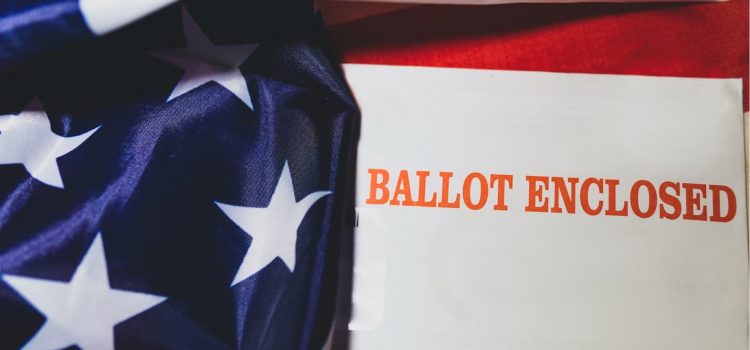
This is a free excerpt from one of Shortform’s Articles. We give you all the important information you need to know about current events and more.
Don't miss out on the whole story. Sign up for a free trial here .
What is ranked-choice voting and how does it work? What benefits does ranked-choice voting promise voters?
Ranked-choice voting is gaining popularity across the United States with advocates claiming it gives a voice to people who don’t feel represented by polarizing candidates. But the jury’s still out on whether it’s a step forward or backward for U.S. democracy.
Keep reading to learn what ranked-choice voting is and how it works.
Ranked-Choice Voting—Explained
What is ranked-choice voting (RCV)? RCV is a system in which voters rank candidates by preference on their ballots and is gaining popularity across the United States. A new political party, Andrew Yang’s Forward, is even building a platform around making ranked-choice voting mainstream. Most recently, Alaska made headlines for ranked-choice voting elections that shook up the state’s recent political history. But the 49th state is not alone in experimenting with this system:
- Alaska, Nevada, Hawaii, Kansas, and Wyoming implemented RCV during the 2020 Democratic presidential primaries. Virginia implemented RCV during the 2021 Republican convention to choose their gubernatorial candidate.
- Alaska and Maine have implemented RCV in federal and state elections.
- 32 cities implemented RCV in local elections in 2021, including 23 cities implementing it for the first time.
- Also in 2021, Utah, Colorado, and Maine passed pro-RCV legislation into law. In addition, Austin (TX), Burlington (VT), Ann Arbor (MI), Broomfield (CO), and Westbrook (ME) approved ballot referendums to implement RCV in upcoming local elections.
Despite its increasing popularity, the jury’s still out on whether ranked-choice voting is a step forward or backward for U.S. democracy. Proponents believe it gives a voice to people who don’t feel represented by polarizing candidates, and that it avoids spending money in run-off elections. Opponents argue that it’s too complex, making implementation difficult and taking too much time to confirm results, which undermines trust in the electoral process.
In fact, just as RCV picks up steam, opposition to it is also growing—though critics contend this is due to certain candidates benefiting from the current polarization and status quo. Here are some examples of the bipartisan opposition RCV faces:
- Florida governor Ron DeSantis (R) signed a bill that will prevent cities from using ranked-choice voting, even if, as is the case in Sarasota, voters have already expressed their desire to adopt the system.
- Tennessee state Senator Brian Kelsey (R) sponsored a bill that passed in February, which will also keep Tennessee residents from choosing to switch to RCV—something Memphis voters chose in 2008 and recommitted to in 2018.
- Eric Adams (D), now New York mayor, opposed RCV in the lead-up to the New York City mayoral elections, and he seemed to support a group of Democrats who tried to delay the implementation of the system New Yorkers had decided on the previous year.
- California Governor Gavin Newsom (D) vetoed a bill that would have allowed more cities in the state to choose to apply RCV in their local elections.
How It Works
Before diving into the promises and possible drawbacks of ranked-choice voting, let’s explore how it works to better understand what ranked-choice voting is. The voting system most people are familiar with is “plurality voting,” in which the candidate who gets the most votes wins, even if they don’t get a majority of votes. In some countries, a candidate must get a majority of the votes to win (such as in the recent first round of presidential elections in Brazil), and when that doesn’t happen, a run-off or second round takes place so that one of the candidates can reach a 50% majority.
A ranked-choice election is different from both plurality and majority votes. Here’s the basic process followed in a ranked-choice election:
1) Voters assign a number to each candidate on the ballot. Their top choice is number 1, their second choice is number 2, and so on.
2) Once all the votes are in, the first-choice votes are counted. If a candidate receives more than 50% of the first-choice votes, they are declared the winner.
3) If no candidate receives more than 50% of the votes, whoever got the fewest first-choice votes is disqualified. That candidate’s ballots are then processed to see who their voters chose as a second choice, and those votes are distributed accordingly among the remaining candidates.
4) At this point, if a candidate has reached 50%, they are declared the winner.
5) If no candidate has reached 50% by this point, once again the candidate with the least votes so far is disqualified and their voters’ second-choice votes are added to the running tally.
6) This process continues until a candidate reaches the 50% threshold.
What It Promises
Advocates of ranked-choice voting argue that the system offers these benefits:
More Participation at a Lower Cost
There will be no need for run-off elections that cost time and money, and demand voters to upend their daily routines more than once.
At the same time, young people will increase their participation. Research suggests that the higher levels of civility and mobilization that characterize RCV incentivize more young people to come out to vote.
Less Polarization, More Consensus
Elections will produce officials who enjoy broad support from voters, rather than polarizing individuals who gain a plurality of votes and alienate the rest of the electorate. Consequently, elected candidates will feel indebted to a broader swath of voters, rather than niche voters with specific policy preferences, and they will have a stronger mandate to govern according to their campaign platforms. Vocal constituents who come out to vote during low-turnout primaries would wield less power compared to the rest of the electorate who come out to vote on Election Day.
Along the same lines, campaigns and elections will be more civil because candidates need to woo voters who prefer other candidates to choose them as their second choice. This might prevent candidates from attacking each other since they wouldn’t want to alienate anyone’s voter base. Candidates would also have the option to cooperate with each other and build coalitions in a way that traditional elections don’t allow.
More Ideological and Demographic Diversity
There will be more ideological diversity. Instead of having to be strategic and vote for the “lesser of two evils” or a candidate they don’t really like only because they have the best chance of winning, voters will have the freedom to vote their conscience. They can choose the candidates they really support as their first choice and rank all the other candidates in the order of their preference. This can help prevent the scenario, common in a plurality or majority vote, where voting your conscience might lead you to believe that you’ve “wasted” your vote by choosing someone with slim chances, such as a third-party candidate.
Along the same lines, third-party candidates will not “split the vote” and still get to demonstrate the popularity of their ideas. Voters who believe in their platforms can choose them as their first choice and still have a say over which of the candidates most likely to win should ultimately get the job by selecting that person as their second choice. Thus, voters’ values and policy interests will be made known without sacrificing their say over the final winner.
Further, RCV will give a voice to voters who don’t feel represented by either major party. Critics of the two-party system claim that it is at the root of the current polarization, and that RCV would open up the field to more options.
Regarding demographic diversity, women and candidates of color will benefit from the transfer of votes. Case studies show that voters who pick a woman as their first choice tend to pick a woman as their second choice as well, thus giving female candidates in general a bump, even if their first choice gets eliminated. Cities that have used RCV more than once have seen female representation grow with each election cycle. And candidates of color earn more seats in RCV elections, especially in districts where people of color are in the majority. They also benefit from voters not having to choose between two candidates of color, since they can rank them in order of preference and demonstrate their support for both.
No Wasted Votes
In many elections, some candidates drop out close enough to the final voting day that many voters have already voted for them. About 13% of all votes cast in the 2020 Democratic primaries were wasted on candidates who had dropped out, and in 2016 more than half a million votes were wasted in the Republican primaries. RCV would allow voters to select more than one candidate, so if their top choice drops out of the race, they still have a say in the final result.

Want to fast-track your learning? With Shortform, you’ll gain insights you won't find anywhere else .
Here's what you’ll get when you sign up for Shortform :
- Complicated ideas explained in simple and concise ways
- Smart analysis that connects what you’re reading to other key concepts
- Writing with zero fluff because we know how important your time is






